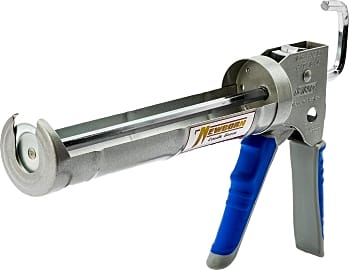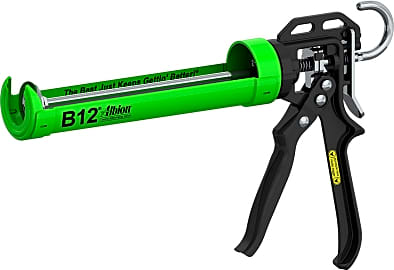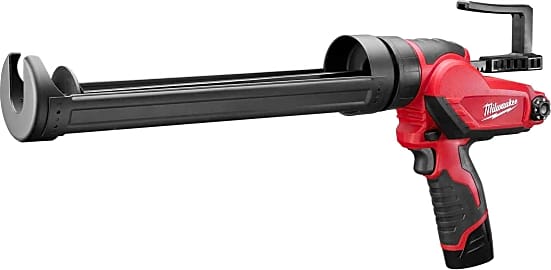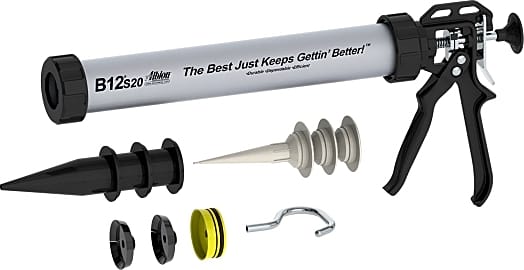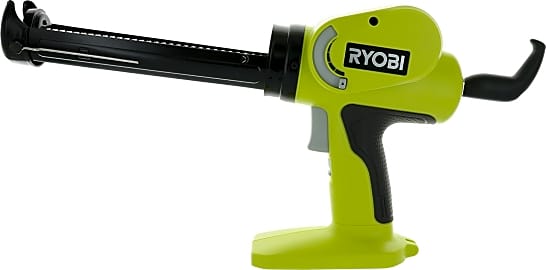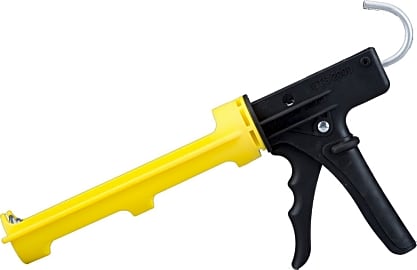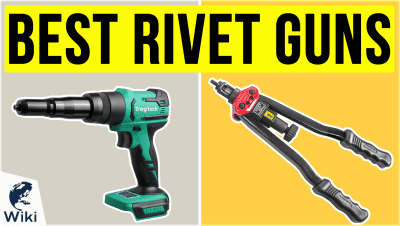The 10 Best Caulking Guns

This wiki has been updated 35 times since it was first published in May of 2016. If you're a professional plumber, tile installer or construction worker, chances are pretty good that one of these caulking guns will come in extremely handy at some point. The same goes for those of you with a bunch of do-it-yourself projects lined up. They're ideal for quickly and accurately dispensing fillers, adhesives and sealants around bathtubs, sinks, toilets and floors. When users buy our independently chosen editorial choices, we may earn commissions to help fund the Wiki.
Editor's Notes
September 08, 2020:
Since we did not discover many glaring quality or performance concerns with this list, we only needed to make a small number of adjustments. We did, however, have to remove the Gamut Gun from the Special Honors section due to a lack of availability.
In evaluating the Albion Engineering B12, we determined that its pumping action requires less effort than many similar guns, noting its smooth operation in the bullet points. We also highlighted the comfortable handle of the Newborn 250 Super, and pointed out that the Dripless Ergo Composite can require quite a bit of effort when dispensing certain materials, which is why we gave it a slight downgrade.
We added an air-powered model (the Chemicar Pneumatic) to the Special Honors section, an all-metal tool that’s available with or without an airflow regulator. A handy pressure release valve allows you to abruptly stop flow of the sealant to prevent excess distribution.
June 05, 2019:
Once we assessed the Tarvol Industrial, it became clear that this model is quite difficult to utilize effectively, with an oversized handle that hinders your grip and sharp edges that will cut your skin if you’re not careful. It also tends to rattle, creating an irritating sound. We eliminated this model from the list.
In identifying a replacement, we decided to go with a battery-powered unit, as the list already contains a wide variety of manual tools. Milwaukee is a trusted, established name in power tools, and reports suggest that the 2441-21 electric gun lives up to the company’s standards. It’s surprisingly lightweight and nimble, allowing users to apply caulk in tricky, hard-to-reach areas without becoming frustrated and tired quickly (as would be the case with many standard guns).
Contractors and non-professionals alike seem thrilled with both Newborn models on the list. The 90-GTD is a reliable, low-cost tool with a high-quality drip prevention system and a comfortable, well-designed handle that provides the user with excellent handling and control. The 250 Super is a bit pricier (due to its enhanced thrust ratio, versatile rotating frame, and more attractive appearance), but reports are equally positive. We moved each up slightly in the rankings.
Special Honors
Trademark Soundproofing Carpenters and plumbers aren’t known for babying their tools, which is why this Trademark Soundproofing model is built with a resilient, powder-coated frame to ensure it remains on the proverbial playing field and off the injured list. It’s compatible with standard quart cartridges. tmsoundproofing.com
Kraft Professional This is a no-frills tool that should suffice for home improvement projects or a contractor on a budget. It’s easy to slide a cartridge into the barrel, which can then be swiveled to achieve different angles as you work. It has a curved, comfortable trigger and a ladder hook for hanging. krafttool.com
Chemicar Pneumatic If you’re looking to minimize the amount of physical effort exerted on the job, a pneumatic gun may be a nice change of pace. It’s compatible with standard plastic and metal cartridges, and it comes with or without a pre-installed air flow regulator. Its tough metal body should provide long-term durability. chemicar.com
Choosing A Caulking Gun
Caulking guns help their users apply an even amount of material at a constant rate, leaving behind a clean, functional space.
Using a good caulking gun makes finishing the construction or remodel of a bathroom, kitchen, or any other space that needs seams sealed against water a pleasantly easy project. Caulking guns help their users apply an even amount of material at a constant rate, leaving behind a clean, functional space. This basic, affordable tool is an essential part of any professional builder's arsenal, and is a good idea for the homeowner (or the handy renter) to keep around, as well.
Most caulking guns operate using a pistol grip shape complete with a trigger-style handle squeezed by all four fingers at once. They allow for generous distribution of caulk with each squeeze and are easy to control with your grip strength serving as the source dispensing power.
For the person with limited hand strength caused by age, accident, or illness, however, these hand-operated caulking guns may not be the best choice. So, too, might the contractor or remodeling professional who goes through dozens of tubes of caulk in a given work week consider another option: the powered caulk gun.
Caulking tools that use a power source other than your hand fall into one of two categories: the electrically-operated tool, and the pneumatically-powered variety.
Battery-operated caulk guns reduce the strain put on the fingers and forearm of the operator, yet are rather heavy when compared to basic caulk guns, which might be a drawback for some people. They can be used anywhere, and with practice, they let their operator dispense nearly endless amounts of caulk in smooth, steady lines.
Pneumatic caulk guns require the use of an air compressor or air tank, which can be a limiting factor. They are lighter than batter-powered units, though, while still offering the same ease-of-use.
Proper Caulking Technique
Before you commence installing new caulk around a bathtub, sink, toilet, or in the gaps between tile, you need to remove as much of the old and worn-out caulk as possible. For new fixtures and/or tile, make sure the surfaces where you will be working are as clean and dry as possible, as dust, dirt, and moisture can prevent a proper bond. Use razor blades, the tip of a screwdriver, and brushes with stiff bristles to remove old caulk and grit, and consider running a high-powered vacuum around the area you have prepared.
You can also use sand paper to lightly buff away small patches of caulk that strayed from their intended borders.
When you cut the tip off of a tube of caulk, do so at an approximate 45-degree angle for applying caulk to seams with 90-degree corners, like you'd find around the rim of a tub or the pan of a shower. An opening of around 1/8-inch should be sufficient for these and similar projects. For applying caulk between tiles (or for other fine applications, such as woodworking), try a more acute angle and a smaller hole; a 60- or 70-degree cut off the tip and a 1/16-inch opening will allow for more precise distribution of caulk into smaller gaps.
Any experienced contractor will tell you that one of the best tools for proper caulk installation is a moistened finger. There is often no better way to help create a smooth, rounded, and seamless bead of caulk than by slowly and steadily running your finger along the corner or crack the material is filling. Most types of caulk are perfectly harmless to human skin, though you should be sure to wash your hands thoroughly to remove any traces left behind before they dry. You can also don a tightly fitting rubber glove to keep your hands clean while shaping the seams and strips you have dispensed. Just make sure to dip it in water frequently while you work.
There are also multiple caulk shaping tools available that can help you create a crisp, clean edge in fresh caulk. Most are made from plastic that is sturdy and rigid, but that will not scratch tile, porcelain, or other plastic components. Make sure to thoroughly clean the shaping tools as soon as you have finished using them.
To trim caulk that has dried, use as sharp a knife as you can, and trim the caulk in long strips. You can also use sand paper to lightly buff away small patches of caulk that strayed from their intended borders. If you think you will have trouble applying a smooth and steady bead of caulk, consider preparing the work space with masking tape leaving only the intended areas exposed.
How To Choose the Right Caulk
A caulking gun is a perfect example of an item that is absolutely useless on its own. You can use a caulk gun productively in one way only, and that is to distribute caulk from a tube. (Coincidentally, the tube of caulk designed for use in a caulking gun is worthless without its purpose-built counterpart; they are almost impossible to use by hand.)
Silicone caulk is highly flexible and completely waterproof, making it perfect for use around drains, faucets, and so forth.
For most projects, a general purpose caulk made of an acrylic-latex blend will serve admirably. This material resists water, is generally flexible, even over time, and is low-cost. Consider a quick-drying option for an area you cannot avoid using for a protracted period, such as a kitchen sink. Note that some acrylic-latex caulks respond well to paint, while others are best left unpainted as painting may lead to cracks and flakes as it shrinks over time. (This is usually the case with cheaper options only, though.)
Silicone caulk is highly flexible and completely waterproof, making it perfect for use around drains, faucets, and so forth. It cannot be painted, however, so consider it for out-of-sight applications, like the area around a garbage disposal or the pipes behind the toilet. Silicone caulk is also good for use in areas where the temperature fluctuates, as it resists expansion and contraction.
Finally, for outdoor caulking projects such as sealing gutters or filling gaps in a window frame, try butyl rubber caulk. This thick material is waterproof, flexible, and resilient, standing up to the ravages of weather, motion caused by wind, and impacts from falling twigs, pine cones, and other debris. Butyl rubber caulk tends to give off lots of VOCs (volatile organic compounds), so work with it only in a well-ventilated area and consider wearing protection over your mouth and nose.
When selecting a caulk, don't overlook the simplest factor: make sure the product you are considering will fit in the caulking tool you own or are considering buying. (This consideration is of special importance if you chose a non-standard unit, such as a miniature caulking gun.)



